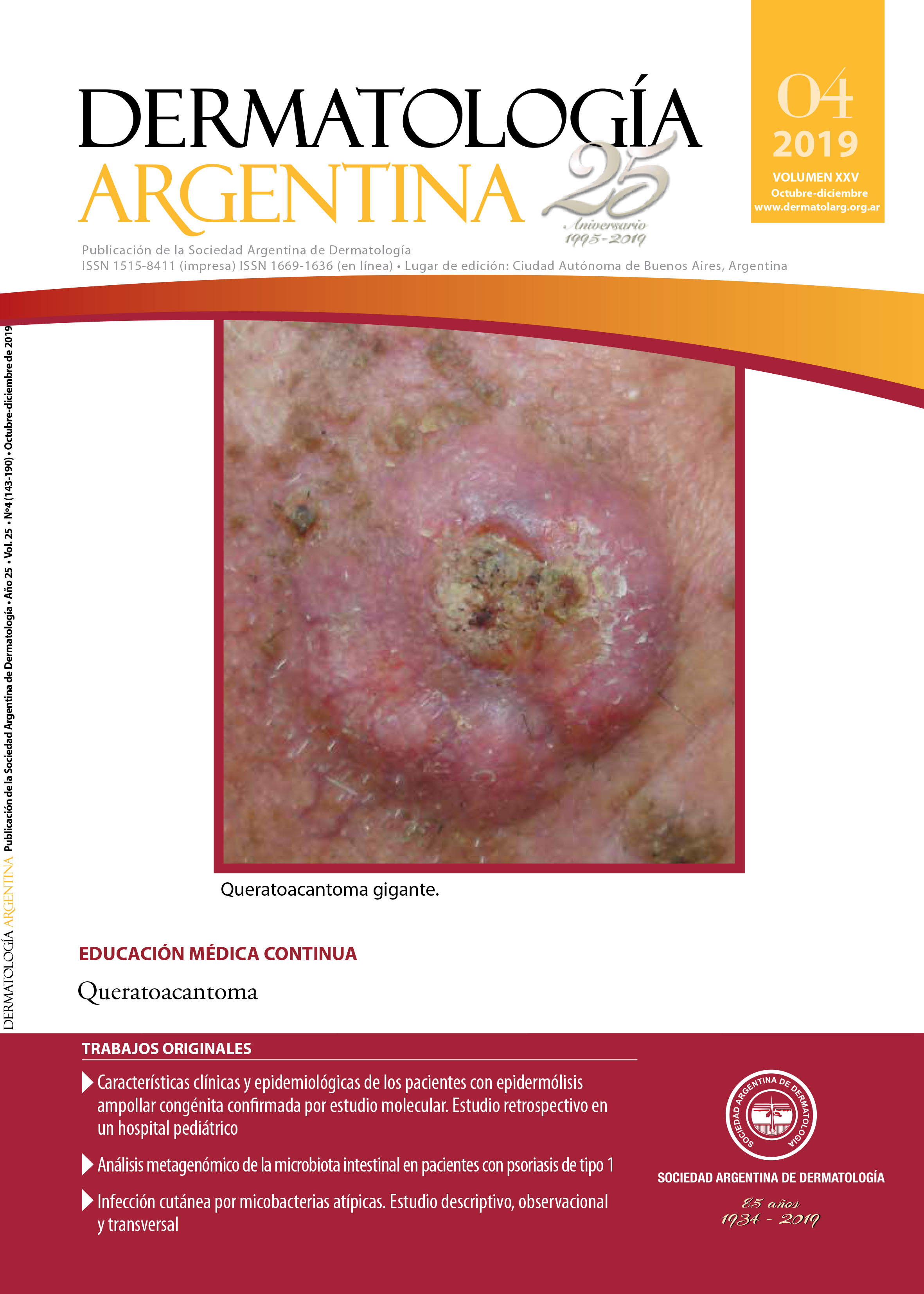Clinical and epidemiological characteristics of patients with congenital epidermolysis bullosa confirmed by molecular study. Retrospective study in a pediatric hospital
Keywords:
congenital epidermolysis bullosa, molecular diagnosisAbstract
Introduction: congenital epidermolysis bullosa (EB) can be difficult to differentiate clinically, so molecular study in essential for the diagnosis of certainty.
Objectives: to describe the epidemiological and clinical characteristics of patients with different types of congenital EB confirmed by molecular study. To determine whether the time of onset of the skin lesions correlates with a certain type of EB. To analyze if there is a correlation between the type of EB and the mode of inheritance clinically suspected with the result of the molecular analysis. To number genetic variants that have not been previously reported.
Design: descriptive, retrospective and transversal study.
Materials and methods: Patients with confirmed diagnosis of EB by molecular test that were evaluated at the Dermatology Department of the Hospital Nacional de Pediatría Prof. Dr. Juan P. Garrahan, from August 1988 until July 2019 were included.
Results: of the 57 patients, 45 (79%) were dystrophic EB, 11 (19%) were simplex EB and one (2%) was a Kindler syndrome. In 91% (52 patients), regardless of the EB type, skin lesions started within the first 30 days of life, while in the regarding 9% (5 patients) appeared between the first month and the first year and all of them were dystrophic EB. There was a 91% correlation between the clinical and genetic diagnosis. Seventeen new pathogenic variants have been found.
Conclusions: the clinical manifestations and the pathogenic variants are essential for the definitive diagnosis of the types of EB and the mode of inheritance.
References
I. Siañez-González C, Pezoa-Jares R, Salas-Alanis JC. Epidermólisis ampollosa congénita: revisión del tema. Actas Dermosifiliogr 2009;100:842-856.
II. Torres-Iberico R, Palomo-Luck P, Torres-Ramos G, LipaChancolla R. Epidermólisis bullosa en el Perú: estudio clínico y epidemiológico de pacientes atendidos en un hospital pediátrico de referencia nacional, 1993-2015. Rev perú med exp salud publica 2017;34:201-208.
III. Fine JD, Eady RA, Bauer EA, Bauer JW, et ál. The classification of inherited epidermolysis bullosa (EB): Report of the third International Consensus Meeting on diagnosis and classification of EB. J Am Acad Dermatol 2008;58:931-950.
IV. Fine JD, Bruckner-Tuderman L, Eady RA, Bauer EA, et ál. Inherited epidermolysis bullosa: updated recommendations on diagnosis and classification. J Am Acad Dermatol 2014;70:1103-1126.
V. Christiano AM, Hoffman GG, Zhang X, Xu Y, et ál. Strategy for identification of sequence variants in COL7A1 and a novel 2-bp deletion mutation in recessive dystrophic epidermolysis bullosa. Hum Mutat 1997;10:408-414.
VI. Glàsz-Bóna A, Medvecz M, Virágh Z, Hatvani Z, et ál. Epidermolysis bullosa simplex with mottled pigmentation - mutation analysis proved the diagnosis in a four-generation pedigree. Eur J Dermatol 2010;20:698-700.
VII. Siegel DH, Ashton GH, Penagos HG, Lee JV, et ál. Loss of kindlin-1, a human homolog of the Caenorhabditis elegans actin-extracellular-matrix linker protein UNC-112, causes Kindler syndrome. Am J Hum Genet 2003;73:174-187.
VIII. Has C, Fischer J. Inherited epidermolysis bullosa: new diagnostics and new clinical phenotypes. Exp Dermatol 2019;28:1146-1152.
IX. Fine JD, Mellerio JE. Extracutaneous manifestations and complications of inherited epidermolysis bullosa: part I. Epithelial associated tissues. J Am Acad Dermatol 2009;61:367-384.
X. Fine JD, Mellerio JE. Extracutaneous manifestations and complications of inherited epidermolysis bullosa: part II. Other organs. J Am Acad Dermatol 2009;61:387-402.
XI. Kim WB, Alavi A, Walsh S, Kim S, et ál. Epidermolysis bullosa pruriginosa: a systematic review exploring genotype– phenotype correlation. Am J Clin Dermatol 2015;16:81-87.
XII. Yang CS, Lu Y, Farhi A, Nelson-Williams C, et ál. An incompletely penetrant novel mutation in COL7A1 causes epidermolysis bullosa pruriginosa and dominant dystrophic epidermolysis bullosa phenotypes in an extended kindred. Pediatr Dermatol 2012;29:725-731.
XIII. Murase K, Kanoh H, Ishii N, Hashimoto T, et ál. Bullous dermolysis of the newborn and dystrophic epidermolysis bullosa pruriginosa within the same family: two phenotypes associated with a COL7A1 mutation. Acta Derm Venereol 2011;91:730-731.
XIV. Youssefian L, Vahidnezhad H, Uitto J. Kindler Syndrome. En: Adam MP, Ardinger HH, Pagon RA, et ál., eds. GeneReviews® . Seattle (WA): University of Washington, Seattle; 2016:1993- 2019.
XV. Lanschuetzer CM, Laimer M, Nischler E, Hintner H. Epidermolysis bullosa nevi. Dermatol Clin 2010;28:179-183.
XVI. Casanova JM, Martí RM, Baradad M, Egido R, et ál. Síndrome de Bart asociado a epidermólisis ampollosa hereditaria letal (Herlitz). Actas Dermosifiliogr 2006;97:658-661.
XVII. Leverkus M, Ambach A, Hoefeld-Fegeler M, Kohlhase J, et ál. Late-onset inversa recessive dystrophic epidermolysis bullosa caused by glycine substitutions in collagen type. XVII. Br J Dermatol 2011;164:1104-1106. 18. Mahto A, McGrath JA, Deroide F, Rustin MH. Late-onset pretibial recessive dystrophic epidermolysis bullosa. Clin Exp Dermatol 2013;38:630-632.
Downloads
Published
Issue
Section
License
El/los autor/es tranfieren todos los derechos de autor del manuscrito arriba mencionado a Dermatología Argentina en el caso de que el trabajo sea publicado. El/los autor/es declaran que el artículo es original, que no infringe ningún derecho de propiedad intelectual u otros derechos de terceros, que no se encuentra bajo consideración de otra revista y que no ha sido previamente publicado.
Le solicitamos haga click aquí para imprimir, firmar y enviar por correo postal la transferencia de los derechos de autor












